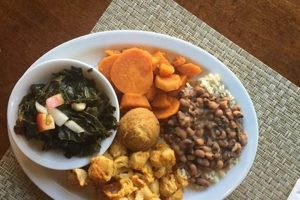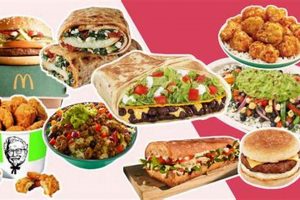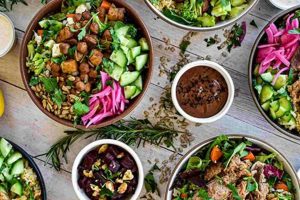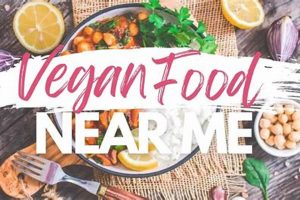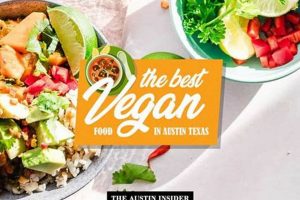Plant-based dining options within the Disneyland Resort offer a variety of meals and snacks that adhere to vegan dietary guidelines. This encompasses dishes prepared without any animal products, including meat, dairy, eggs, or honey. Examples range from modified versions of existing menu items to entirely unique creations tailored for guests seeking exclusively plant-based fare inside the parks and hotels.
The availability of such options reflects an increasing demand for inclusive dining experiences and aligns with broader trends toward plant-based eating. The inclusion of plant-based alternatives allows individuals with specific dietary restrictions or preferences to fully participate in the Disneyland experience without compromising their values. Furthermore, offering these choices contributes to a more sustainable food system and reduces environmental impact.
The following sections will detail specific locations within the Disneyland Resort where plant-based meals and snacks are readily available, highlighting popular choices and providing insights into how to navigate the menus for suitable options.
These tips offer guidance for optimizing the plant-based dining experience within the Disneyland Resort. Proper planning and awareness of available resources are crucial for individuals adhering to vegan dietary guidelines.
Tip 1: Advance Menu Review: Prior to arrival, consult the Disneyland Resort website or mobile application to examine restaurant menus. Many establishments now indicate plant-based options directly on their menus, facilitating efficient meal planning.
Tip 2: Utilize Mobile Ordering: Employ the Disneyland mobile app’s mobile ordering feature. This allows ample time to scrutinize ingredients and customize orders to ensure compliance with vegan standards. Specify modifications in the order notes.
Tip 3: Engage Cast Members: Do not hesitate to directly inquire with Cast Members regarding ingredient information or potential modifications. They can often provide valuable insights and connect guests with chefs for more complex inquiries.
Tip 4: Focus on Quick Service Locations: Quick service restaurants often provide the most easily customizable options, such as substituting plant-based protein or omitting dairy-based sauces. These locations generally offer quicker turnaround times.
Tip 5: Pack Supplemental Snacks: Consider bringing personal plant-based snacks to supplement available options, particularly for extended park visits. This ensures that dietary needs are met throughout the day.
Tip 6: Consider Table Service Reservations: For table service restaurants, make advance reservations and indicate dietary restrictions during the booking process. This allows the culinary team to prepare accommodating dishes.
Tip 7: Explore Festival Offerings: During seasonal festivals at Epcot, many booths feature innovative plant-based dishes. Refer to festival guides for designated vegan options.
By following these guidelines, guests can confidently navigate the culinary landscape of the Disneyland Resort and enjoy a fulfilling plant-based dining experience. Proactive planning and open communication with dining staff are key to success.
The subsequent section will provide specific restaurant recommendations and highlight notable plant-based dishes available throughout the Disneyland Resort.
1. Menu Identification
Menu identification serves as the initial and crucial step in accessing plant-based fare within the Disneyland Resort. The effectiveness of menu identification directly impacts the ease and success with which guests adhering to vegan dietary guidelines can navigate the available culinary offerings. Clear and accurate menu labeling is paramount; the absence of such clarity necessitates heightened scrutiny and potentially limits dining choices. For example, restaurants that explicitly mark vegan entrees with a symbol or designation facilitate informed decisions, reducing ambiguity and saving valuable time. Conversely, menus lacking such indications require patrons to engage in a more detailed inquiry regarding ingredients and preparation methods.
The availability and accuracy of plant-based options on menus also affects the overall perception of inclusivity within the dining environment. When vegan options are prominently displayed and clearly described, it signals a commitment to accommodating diverse dietary needs. This, in turn, enhances the overall guest experience for individuals seeking these options. Furthermore, digital menus, such as those available through the Disneyland app, allow for frequent updates and more detailed ingredient lists, offering a dynamic resource for menu identification that printed menus cannot replicate. Restaurants failing to maintain up-to-date menus or provide accurate information can lead to confusion and dissatisfaction among guests.
In conclusion, menu identification is a fundamental component of enabling plant-based dining within the Disneyland Resort. Accurate labeling, accessible digital resources, and a commitment to transparency are essential for ensuring that guests can confidently and efficiently identify suitable meal options. The effectiveness of this initial step ultimately determines the extent to which individuals can enjoy a comprehensive and fulfilling plant-based culinary experience within the parks and hotels.
2. Ingredient Verification
Ingredient verification is a critical process for individuals seeking vegan food options within the Disneyland Resort. The practice involves careful examination of ingredients and preparation methods to ensure adherence to strict plant-based dietary guidelines. This due diligence is essential due to variations in menu labeling, potential cross-contamination risks, and the prevalence of hidden animal-derived ingredients in seemingly vegan-friendly dishes.
- Hidden Animal Products in Sauces and Dressings
Many sauces and dressings, particularly in casual dining settings, may contain undisclosed animal products such as honey, dairy derivatives (whey, casein), or fish sauce. Thorough ingredient verification requires questioning the composition of these condiments and requesting plant-based alternatives when available. For example, certain marinades used on grilled vegetables may contain honey, necessitating a request for modification or substitution.
- Cross-Contamination Concerns in Food Preparation
Even when ingredients are inherently plant-based, the potential for cross-contamination during food preparation poses a significant concern. Shared cooking surfaces, utensils, and frying oil can introduce traces of animal products into vegan dishes. To mitigate this risk, individuals should inquire about kitchen practices and request that meals be prepared using separate equipment. For instance, fries cooked in the same oil as breaded chicken are not suitable for vegan consumption due to cross-contamination.
- Misleading Menu Descriptions and Labeling Inaccuracies
Menu descriptions may not always accurately reflect the complete ingredient list, leading to unintentional consumption of animal products. Ingredients may be omitted from descriptions due to space constraints or oversight. To prevent errors, it is advisable to consult with restaurant staff or chefs regarding specific ingredients. A dish labeled as “vegetable stir-fry” might inadvertently contain oyster sauce or other non-vegan components.
- Processed Ingredients and Additives
Certain processed ingredients and additives used in food preparation may be derived from animal sources. Examples include gelatin, used as a thickening agent, and some food colorings. Ingredient verification requires scrutinizing labels for these potentially problematic additives. Certain brands of vegetable broth, for instance, may contain animal-derived flavor enhancers or fat.
The process of ingredient verification underscores the need for vigilance and proactive communication when seeking vegan meals at the Disneyland Resort. It highlights the responsibility of the consumer to ensure the suitability of their food choices and reinforces the importance of transparency and accurate labeling on the part of dining establishments. Careful attention to detail is essential for guaranteeing a truly plant-based dining experience.
3. Customization Options
The availability of customization options directly influences the accessibility and diversity of plant-based meals within the Disneyland Resort. The inherent lack of explicitly vegan dishes on standard menus necessitates modifications to existing items. This process often involves the removal of animal-derived ingredients, such as cheese, dairy-based sauces, or meat components. The feasibility and acceptance of such requests by restaurant staff are critical factors. For example, a vegetarian burger can become vegan by omitting cheese and ensuring the bun does not contain milk or egg. The willingness of culinary teams to accommodate these requests expands the range of viable choices for guests adhering to vegan dietary guidelines.
The impact of customization extends beyond simple omissions; it also encompasses ingredient substitutions. The availability of plant-based alternatives, such as vegan cheese, plant-based meat substitutes, or egg-free mayonnaise, enhances the potential for creating satisfying and flavorful vegan meals. Restaurants that stock these ingredients empower guests to adapt dishes to their specific requirements. A practical application of this principle can be observed in the adaptation of pasta dishes. A standard pasta primavera, initially prepared with butter and parmesan cheese, can be modified by substituting olive oil and nutritional yeast, thereby rendering it suitable for vegan consumption. The level of flexibility afforded by culinary staff directly correlates with the success of plant-based dining within the resort.
Ultimately, the breadth and acceptance of customization options significantly shape the plant-based dining landscape at the Disneyland Resort. A restrictive approach limits choices and necessitates increased reliance on pre-existing vegan menu items, which may be scarce. Conversely, a proactive and accommodating approach empowers guests to adapt a wider array of dishes to their dietary requirements, increasing satisfaction and demonstrating a commitment to inclusivity. Understanding the specific customization policies and ingredient availabilities at different dining locations is therefore essential for guests seeking plant-based meals.
4. Cross-Contamination Risks
Cross-contamination presents a significant challenge to the accessibility and reliability of vegan food at the Disneyland Resort. Despite the presence of plant-based menu items or customization options, the risk of unintended contact with animal-derived substances during food preparation compromises the integrity of these offerings. This risk stems from shared cooking surfaces, utensils, and frying mediums, resulting in the transfer of animal fats, proteins, or other non-vegan ingredients to dishes intended for vegan consumption. For example, french fries fried in the same oil as breaded chicken or vegetables grilled on a surface previously used for meat are technically no longer compliant with vegan dietary standards. This necessitates a heightened level of awareness and proactive inquiry from individuals seeking strictly plant-based meals.
The mitigation of cross-contamination risks requires robust food handling protocols and transparency from dining establishments. Dedicated cooking zones, separate utensils, and thorough cleaning procedures are essential for preventing unintentional exposure to animal products. Clear communication between restaurant staff and patrons is also crucial. Individuals should explicitly inquire about potential cross-contamination risks and request that their meals be prepared using separate equipment. Certain Disneyland restaurants have implemented allergen-friendly procedures that, when properly applied, can minimize cross-contamination. However, reliance on such measures underscores the need for continued vigilance and due diligence. The consequences of neglecting these precautions range from mild dietary discomfort to significant ethical violations for strict vegans.
In summary, cross-contamination represents a persistent obstacle to the reliable provision of vegan food at Disneyland. Addressing this challenge demands a multi-faceted approach involving enhanced food safety protocols, transparent communication, and proactive engagement from consumers. While Disneyland has made progress in accommodating diverse dietary needs, sustained effort is required to minimize cross-contamination risks and ensure that vegan menu items consistently meet the standards expected by patrons adhering to plant-based lifestyles. The ongoing assessment and improvement of these practices are essential for fostering a truly inclusive and accommodating dining environment.
5. Nutritional Adequacy
Nutritional adequacy represents a critical consideration within the context of plant-based dining at the Disneyland Resort. Ensuring that available vegan options provide a balanced and sufficient intake of essential nutrients is paramount, given the potential for dietary imbalances in restricted diets. The following facets explore key aspects of nutritional adequacy relevant to vegan food choices within this setting.
- Protein Sources and Completeness
Vegan diets require careful planning to ensure adequate protein intake from diverse plant sources. Disneyland’s plant-based offerings should ideally include protein-rich options such as tofu, tempeh, lentils, beans, or nuts. The completeness of protein refers to the presence of all essential amino acids. If Disneyland offers dishes relying solely on grains or vegetables, the amino acid profile might be incomplete, necessitating complementary protein sources throughout the day. An example would be ensuring a meal with rice is supplemented with beans or nuts at a later time.
- Vitamin B12 Availability
Vitamin B12 is primarily found in animal products, making supplementation or fortified foods essential for vegans. Disneylands plant-based menus should include fortified foods, such as plant-based milks or nutritional yeast, or explicitly recommend B12 supplementation. Without adequate B12 intake, vegans face the risk of neurological problems and anemia. For instance, a Disneyland breakfast could offer fortified plant-based milk with cereal or a side of nutritional yeast-sprinkled tofu scramble to address this need.
- Iron Absorption and Bioavailability
Iron from plant-based sources (non-heme iron) is less readily absorbed than iron from animal products (heme iron). Disneyland’s plant-based dishes should incorporate strategies to enhance iron absorption, such as combining iron-rich foods with vitamin C-rich foods. For example, a spinach salad with citrus dressing or a lentil soup served with a side of bell peppers can improve iron bioavailability. The absence of such strategies could lead to iron deficiency, particularly in individuals with already low iron stores.
- Calcium Intake and Alternatives
Dairy is a common source of calcium in many diets. Disneyland must offer calcium-rich plant-based alternatives, such as fortified plant-based milks, tofu processed with calcium sulfate, or calcium-rich vegetables like kale or broccoli. Ensuring adequate calcium intake is crucial for bone health and overall physiological function. An example would be offering a plant-based yogurt parfait with calcium-fortified granola or a side of steamed broccoli with a plant-based cheese sauce.
In conclusion, ensuring the nutritional adequacy of vegan food options at the Disneyland Resort requires a deliberate approach to menu planning and ingredient selection. Prioritizing diverse protein sources, addressing vitamin B12 requirements, enhancing iron absorption, and providing calcium-rich alternatives are crucial steps in meeting the nutritional needs of vegan guests. By incorporating these considerations, Disneyland can provide a more complete and health-conscious plant-based dining experience.
Frequently Asked Questions
This section addresses common inquiries and concerns regarding plant-based dining within the Disneyland Resort, providing accurate and practical information for visitors adhering to vegan dietary guidelines.
Question 1: Are there clearly marked vegan options on Disneyland menus?
While some establishments within the Disneyland Resort offer clearly labeled vegan items, this practice is not universally consistent. Menu labeling varies significantly between restaurants, necessitating proactive inquiry and careful scrutiny of ingredient lists to confirm the absence of animal-derived products.
Question 2: Can existing menu items be modified to accommodate vegan dietary requirements?
Modification of existing menu items is often possible, but depends on the specific restaurant and dish. The extent to which culinary staff are willing and able to accommodate requests varies, requiring direct communication with the establishment to ascertain the feasibility of ingredient substitutions or omissions.
Question 3: What steps are taken to prevent cross-contamination in food preparation?
Cross-contamination presents a persistent challenge. While some establishments implement measures such as dedicated cooking surfaces or utensils, the risk is not entirely eliminated. Individuals with strict vegan requirements should explicitly inquire about preparation methods to minimize potential exposure to animal products.
Question 4: What types of plant-based protein sources are available at Disneyland?
The availability of plant-based protein sources varies. Tofu, tempeh, lentils, beans, and plant-based meat substitutes may be offered at select locations. The diversity and quality of these options directly influence the nutritional adequacy of vegan meals within the resort.
Question 5: How can one ensure adequate intake of essential nutrients on a vegan diet at Disneyland?
Ensuring adequate nutrient intake requires careful planning and awareness of available options. Supplementing meals with nutrient-rich snacks or selecting dishes fortified with essential vitamins and minerals may be necessary to address potential dietary deficiencies.
Question 6: Where can I find the most comprehensive and up-to-date information about vegan food options at Disneyland?
The Disneyland Resort website and mobile application serve as valuable resources for menu information. However, the most reliable approach involves directly contacting individual restaurants or speaking with culinary staff to confirm ingredients and preparation methods.
Navigating plant-based dining at Disneyland requires diligence, communication, and a thorough understanding of available resources. Proactive planning and informed decision-making are essential for a satisfactory and nutritionally adequate vegan experience.
The subsequent section will provide specific restaurant recommendations and highlight notable plant-based dishes available throughout the Disneyland Resort.
Conclusion
The exploration of vegan food in Disneyland reveals a landscape of increasing, yet still evolving, accommodations. While the availability of plant-based options has expanded, consistent and reliable access requires proactive engagement and diligent verification by consumers. Discrepancies in menu labeling, potential for cross-contamination, and nutritional considerations necessitate careful planning and informed decision-making.
The continued demand for plant-based options will likely drive further improvements in the Disneyland Resort’s culinary offerings. Increased transparency in menu information, enhanced food safety protocols, and a greater variety of nutritionally balanced vegan choices are crucial for fully accommodating the dietary needs of all guests. The future of vegan dining in Disneyland hinges on a sustained commitment to inclusivity and a proactive approach to meeting the evolving needs of its diverse clientele.


